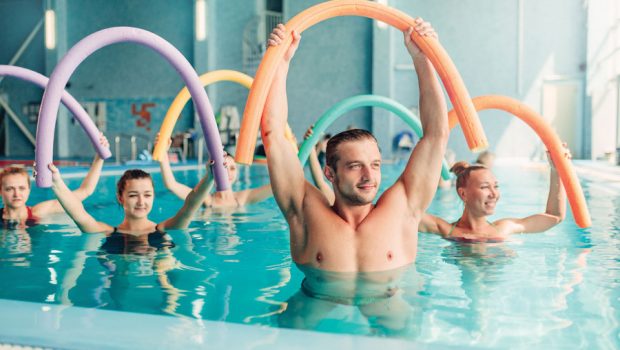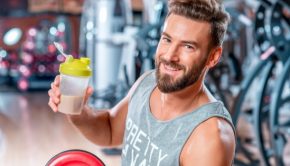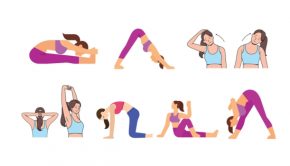JUST ADD WATER
Aquatic Workouts for Him
by Marlaina Donato
When it comes to chiseling muscles, recovering from injury or reducing stress, men are finding that hitting the pool might even surpass hitting the gym. “Water aerobics is a great form of exercise for men looking to sculpt their bodies, because water offers multidirectional drag resistance that assists in developing muscle balance within the body,” says Denver aquatic fitness trainer Sean Sullivan.
Pool workouts offer men and women of all ages and condition a low-impact, energizing way to get fit and burn calories. From specialized classes for patients with Parkinson’s disease to relief from the pain of arthritis and fibromyalgia, water aerobics harbors benefits for everyone.
The Mayo Clinic adds improved cardiovascular health to the reasons why more men are joining classes that were previously considered to be a women’s domain. A recent meta-analysis of 14 studies published in the European Journal of Preventive Cardiology found that aquatic exercise can significantly lower blood pressure. Another study published in the Asian Journal of Sports Medicine reached a similar conclusion when men that underwent 55 minutes of aquatic exercise three times a week exhibited marked reductions in hypertension.
Go Vertical for Stronger Muscles
Water aerobics classes, which don’t involve swimming, are conducted in waist-high water. These vertical workouts provide 75 percent more resistance than land-based exercise. “When you perform a bicep curl in the water with no equipment, not only do you exercise the bicep muscle on the way up, but because of drag resistance, you’re also exercising your triceps muscle on the way down, for a balanced workout,” says Sullivan.
Exercise physiologist Clinton Maclin, of the Piedmont Atlanta Fitness Center, in Georgia, concurs. “Aqua aerobics helps all muscle groups benefit from increased endurance, resistance and range of motion.” For optimum fitness, Maclin recommends getting wet for a minimum of two-and-a-half hours per week to stay in condition.
The heart is also a muscle that benefits greatly from aquatic fitness. “Hydrostatic pressure is a property of water that aids in blood flow return to the heart, which may lead to a reduction in heart rate,” says Sullivan. “It’s a physiological benefit from simply immersing oneself in water.”
Less Pain, More Flexibility
A number of recent studies have shown that aquatic exercise can ease pain in conditions such as fibromyalgia and also improve flexibility in joints. It’s recommended by both the Osteoarthritis Research Society International and by the American College of Rheumatology.
In the water, older individuals can exercise without the risk of falling. “The water creates buoyancy, making it less likely to make sudden movements. The low impact of the water allows longer participation time, mobility and stability,” says Maclin. “Seniors can participate in higher-intensity movements and perform more activities, even while injured.”
Aqua aerobics helps improve balance and is also a boon to soft tissue. “Warm water provides a tremendous benefit to tendons and ligaments, adding mobility, flexibility and well-being,” notes instructor and fitness trainer Márcia Wilken, in Shawano, Wisconsin. “Seniors can benefit most from water exercise at least twice a week. It can also improve cognitive thinking and helps to promote a better sleep pattern.”
Rehabilitation, Parkinson’s Disease and Multiple Sclerosis
Aquatic therapy in warm water helps to facilitate recovery after joint surgery and injuries, including anterior cruciate ligament tears in the knee. “Warm pools are a great environment for young athletes recovering from sports-related injuries. Hydrostatic pressure reduces swelling of the injured area, allowing for greater range of motion. Buoyancy reduces the load placed upon the injured area and reduces pain,” says Sullivan. “The properties of water allow injured athletes to begin the recovery process sooner.”
For individuals with Parkinson’s, the American Parkinson Disease Association recommends aquatic exercise for improved balance and pain reduction. In 2014, the European Journal of Experimental Biology published an eight-week Iranian study involving 60 men with multiple sclerosis that concluded it improved balance.
Water resistance does a body good, but the experts suggest one-on-one attention for best results. “I strongly recommend finding an aquatic fitness and rehabilitation specialist, because not all exercises are beneficial for everyone,” says Sullivan.
Wilken agrees. “A trainer can teach technique and different ways to move in the water, as well as proper breathing and good body alignment. It will double the benefits.”
Marlaina Donato is the author of several books on spirituality and clinical aromatherapy. She is also a composer. Connect at AutumnEmbersMusic.com.





























